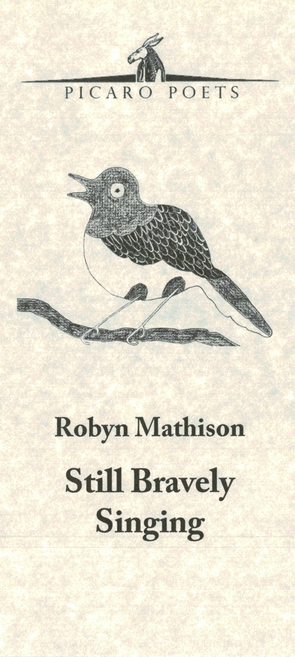
DONALD KNOWLER
Launch: Robyn Mathison's 'Still Bravely Singing'
Hobart Bookshop. 30th November 2017
Birds are our contact point with nature. There are mammals about, and reptiles and amphibians, but we never see or hear them. It’s not obvious they share our world.
Birds are all around us, each and every day. If we can’t see them, we hear them, even in the heart of our cities.
They are also beautiful, or many of them are. They inspire us to flight, to soar in hope and spirit.
Birdsong lifts our day when we are feeling down. It’s no wonder since the birth of humankind we have connected with our avian friends.
And our art reflects this connection. Birds over the millennia have inspired poetry and prose, visual art, and music. It’s even suggested they may have inspired human song, and even speech.
Artists though tend to merely copy the image of a bird, and composers of music their songs. The poets bring something else, something I can’t define.
Bird poetry is as old as British poetry itself, and I speak of British poetry and poetry in the English language because I’m sure poets from the “old country” have fired the Australian desire to put bird song and flight into words.
Over time a remarkable number of British poets have written poems about birds, from Keats’s nightingale and Shelley’s skylark to Yeats’s swans, to Thomas Hardy’s thrush.
But I’m not a poet. I’ve spent my whole working life as a journalist, using words not in prose or poetry but as a simple means of commercial communication.
I’m not a “literary gent” as some tabloid journalists derisively call writers: I ply my trade as a newspaper wordsmith. On my anvil words are hammered and flattened to fit a certain shape, a narrative, to record, to report what I have seen on any given day. I can say, though, they are never twisted or bent.

In contrast, Robyn Mathison can be described as a poet. I first saw her work in Birdsong, published by the Bruny Island Environmental Network, a few years back. Three of her poems, 'Dark Messengers', 'Zosterops lateralis lateralis' (the silvereye) and 'Philomel' were published there, and they are superb. And all three are in Still Bravely Singing I’m happy to say.
I might be a craftsman but Robyn and I share some common ground. My first entry into poetry was actually also published in Birdsong, although I think my contribution might have flown a little lower to the ground than hers.
We also have something in common in that, In my wordsmith, journalistic writings, and Robyn’s poetry we share a habitat where birds gather. This is largely the city and suburbs. In the 'On the Wing' column I write for the Mercury newspaper I describe the birds I see in my garden and the immediate neighbourhood; Robyn uses the birds she sees in her cityscape as subjects for her poems. One poem is even titled .In the City Desert..
Joyous birdsong and the other sounds of nature, like the wind buffeting rain-jewelled leaves - as Robyn writes in 'Mist' - sing from her poems. There is also a dark side, the reality that when wildlife comes into close contact with the human world there is not always a happy outcome.
I hope Robyn will read some of her poems so I won’t tread on her toes, just mention some that struck a chord.
She mentions 19th century Italian philosopher and author Giacomo Leopardi who, in his In Praise of Birds, suggested that where people were gentler birdsong was too. And she asks was the singing of the wattlebirds sweeter prior to 1788.
Yes there is darkness here, like the zoo penguin longing for its far-away home on the ice-shelf, as the lion in the zoo longs for the bushveld. But also hope.
Another poem begins, “The world is full of cruelty and beauty…”
I turn on the TV news in the morning and see man-made horrors, from Myanmar to Syria, to shootings in Texas, that are spread before me. And then, in my garden, a grey fantail, a cranky fan as they are known to Tasmanians, flits and flirts, loops the loop, as Robyn describes it, before pausing to tune his violin. And so the grey fantail’s happy melody brings some cheer to grim mornings, puts a spring in my step as I face the day.
There are roughly 10,000 birds in the world and my research tells me about 1000 of these have been mentioned in poetry.
Although birds are declining in both species and number, they are still bravely singing. So for poets like Robyn, there remains plenty of material out there in the canopy and in the skies to … like birdsong ... bring joy to our lives.
During a lengthy career as a newspaper journalist, Donald Knowler has escaped the “day job” by writing about wildlife. He pursues the genre of new nature writing, and his efforts to connect the human and natural worlds finds expression in the 'On the Wing' column on bird-watching he writes for the Mercury each week.
He is also the author of three books, and has contributed to three others.
His first book, The Falconer of Central Park, was published by Bantam America; and a self-published collection of essays, Dancing on the Edge of the World, was nominated for the Tasmanian Premier’s Literary Prize in 2006. In 2015, Knowler self-published Riding the Devil’s Highway, a study of the roadkill issue in Tasmania.
Knowler also contributed to Central Park: An anthology published by Bloomsbury America in 2014.
Knowler’s Mercury column and his other writing can be found on his website at www.donaldknowler.com